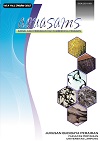ARTIFICIAL POND BOTTOM AND PROBIOTICS APPLICATION FOR AFRICAN CATFISH (Clarias sp.) GROW OUT IN SUPER INTENSIVE CULTURED
Abstract
Catfish has good prospect local market and has opportunity to go international market or export because the quality meat, has good size, and saturated quality condition for export. The big problem in intensive amplification catfish such as competition fir retain movement place because restrictveness basic fish pond.The basic application synthetic and affixture probiotic during amplification to intensive scale as basic alterbative increase production. The purpose in this research to know about the effective basic pond synthetic and addition probiotic to amplification masamo catfish towards biomassa, growth, giving woof and directness life. In thitis research has 3 treatment such as TDB treatment: amplification masamo catfish without use basic pond synthetic, after that in this treatment have name as control treatment. PBK treatment: amplification masamo catfish with addition probiotic in woof and water pond. PDB treatment: commodity.use basic 2 application synthetic pond. The result in this research is different with weight fish and directness with highest score is 1,387gr/day and 96,58% where as growth biomassa and in the conversion woof is nothing different. The basic utilization technology synthetic affixture probiotic capable to increase biomassa 10%. In this problem will have the impact in production and resulted income. The using of woof in amplification masamo catfish is more efficient with the application fish pond synthetic and probiotic. It can been seen from the result woof convertion is gotten. The growth weight and the length of catfish increases with the application fish pond synthetic and probiotic.

.png)










